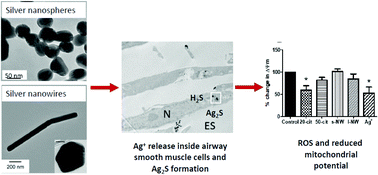Effect of silver nanospheres and nanowires on human airway smooth muscle cells: role of sulfidation†
Abstract
Background: The toxicity of inhaled silver nanoparticles on contractile and pro-inflammatory airway smooth muscle cells (ASMCs) that control airway calibre is unknown. We explored the oxidative activities and sulfidation processes of the toxic-inflammatory response. Method: Silver nanospheres (AgNSs) of 20 nm and 50 nm diameter and silver nanowires (AgNWs), short S-AgNWs, 1.5 μm and long L-AgNWs, 10 μm, both 72 nm in diameter were manufactured. We measured their effects on cell proliferation, mitochondrial reactive oxygen species (ROS) release and membrane potential, and also performed electron microscopic studies. Main results and findings: The greatest effects were observed for the smallest particles with the highest specific surface area and greatest solubility that were avidly internalised. ASMCs exposed to 20 nm AgNSs (25 μg mL−1) for 72 hours exhibited a significant decrease in DNA incorporation (−72.4%; p < 0.05), whereas neither the 50 nm AgNSs nor the s-AgNWs altered DNA synthesis or viability. There was a small reduction in ASMC proliferation for the smaller AgNS, although Ag+ at 25 μL mL−1 reduced DNA synthesis by 93.3% (p < 0.001). Mitochondrial potential was reduced by both Ag+ (25 μg mL−1) by 47.1% and 20 nm Ag NSs (25 μg mL−1) by 40.1% (*both at p < 0.05), but was not affected by 50 nm AgNSs and the AgNWs. None of the samples showed a change in ROS toxicity. However, malondialdehyde release, associated with greater total ROS, was observed for all AgNPs, to an extent following the geometric size (20 nm AgNS: 213%, p < 0.01; 50 nm AgNS: 179.5%, p < 0.01 and L-AgNWs by 156.2%, p < 0.05). The antioxidant, N-acetylcysteine, prevented the reduction in mitochondrial potential caused by 20 nm AgNSs. The smaller nanostructures were internalised and dissolved within the ASMCs with the formation of non-reactive silver sulphide (Ag2S) on their surface, but with very little uptake of L-AgNWs. When ASMCs were incubated with H2S-producing enzyme inhibitors, the spatial extent of Ag2S formation was much greater. Conclusion: The intracellular toxicity of AgNPs in ASMCs is determined by the solubility of Ag+ released and the sulfidation process, effects related to particle size and geometry. Passivation through sulfidation driven by biogenic H2S can outcompete dissolution, thus reducing the toxicity of the smaller intracellular Ag nanostructures.



 Please wait while we load your content...
Please wait while we load your content...